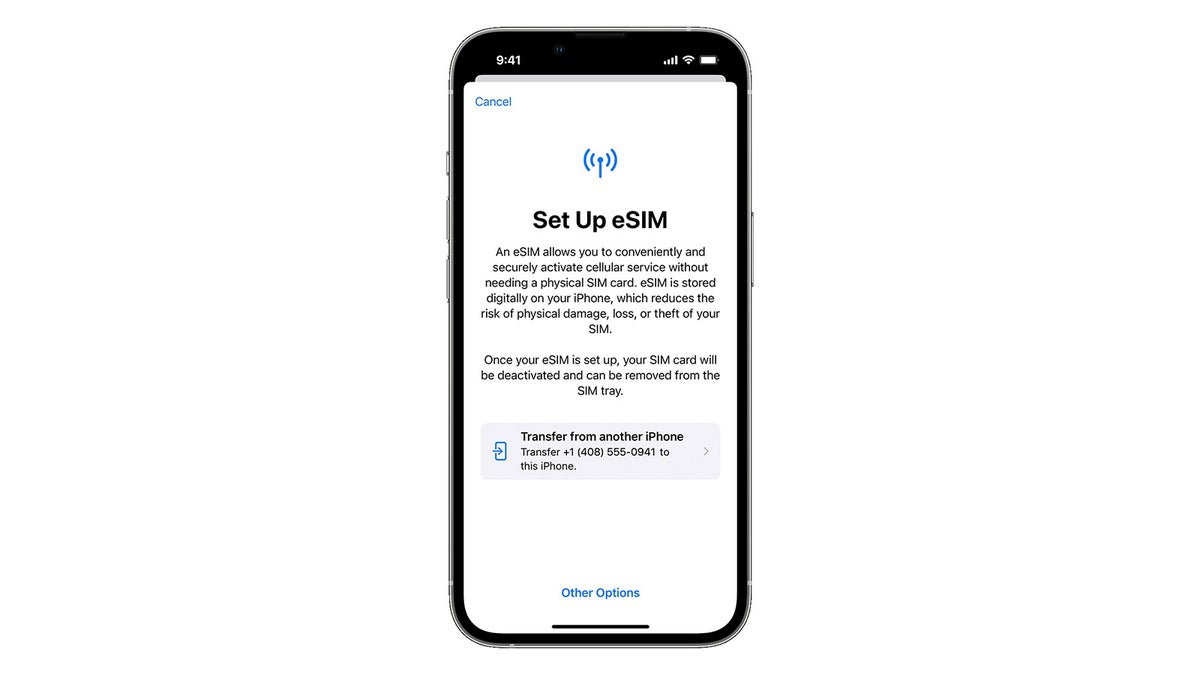iPhone 14 transitions to eSIM: all your questions answered

All iPhone 14 models in the United States no longer have a physical SIM card slot at all. This means that this year, switching to a new iPhone won't be as simple as removing the SIM card from your old device and plopping it in your shiny new iPhone 14.
So how will it work? Well, it will all happen electronically as all US iPhone 14 models now come with dual eSIM support only.
An eSIM is a digital SIM that allows a user to activate a cellular plan without having to visit a store or wait for a physical card, it all happens digitally.
Keep in mind that it is specifically iPhone 14 models sold in the United States that will not have physical SIM card support, while iPhone 14 devices outside the US still have a traditional SIM tray plus support for one eSIM.
An eSIM is a digital SIM that allows a user to activate a cellular plan without having to visit a store or wait for a physical card, it all happens digitally.
Of course, this comes with a bunch of benefits, but also some potential downsides, so read on to understand all the implications of this switch.
We have to also point out that with eSIM, you have all the capabilities of a physical SIM: full access to 4G LTE and 5G carrier networks, same coverage, same everything. Actually, eSIM has been available as an option on iPhones since 2018 when the iPhone XS and XR series first had it, but what changes now is that it is no longer an option, it's the only way.
The biggest issue with the removal of the physical SIM card in the iPhone 14 might be for frequent travelers that are used to popping in a local SIM card for data and avoid paying big roaming fees.
For example, most of the Caribbean countries do not seem to support eSIM, so that is one destination where US travelers might be practically forced to pay for roaming, if they have an iPhone 14. We do, however, expect more carriers to jump on the eSIM bandwagon after Apple's announcement, so we are optimistic most people won't run into troubles.
Benefits of the transition to eSIM:
- No need to deal with a physical SIM card
- Can activate phone remotely much easier
- In case your iPhone gets stolen, thieves will not be able to use it
- More space inside the iPhone chassis for other components
- Network will be able to push an update directly to the phone
- You can test drive a network (T-Mobile allows 3 month trial of its network via eSIM)
- Less waste
Downsides of the transition to eSIM:
- Potential issues when traveling (if you go to Europe or Asia and want to use a prepaid card, will local carriers have pre-paid eSIM cards available? If not, does that mean you will be forced to pay expensive roaming fees?)
- Cannot quickly switch between phones by swapping a card! You have to do it all in software
- Dependent on carrier (will you have to call the carrier every time you want to switch to a new phone?)
- Will carriers one day start to charge for swapping eSIMs?
- The transition might be challenging for elderly people
- Might be problematic with MVNOs (limited support)
The biggest issue with the removal of the physical SIM card in the iPhone 14 might be for frequent travelers that are used to popping in a local SIM card for data and avoid paying big roaming fees.
For example, most of the Caribbean countries do not seem to support eSIM, so that is one destination where US travelers might be practically forced to pay for roaming, if they have an iPhone 14. We do, however, expect more carriers to jump on the eSIM bandwagon after Apple's announcement, so we are optimistic most people won't run into troubles.
Useful link: Apple's official guide to eSIM
Apple supported carriers
In the United States, all three major carriers, T-Mobile, AT&T and Verizon Wireless support eSIM fully.
Curiously, some carriers that also support eSIM like Google Fi are not listed in Apple's official catalog of operators in the US. We are yet to learn whether this means there could be some trouble trying to activate an eSIM iPhone on Google Fi, though.
Useful link: Apple catalog of carriers support eSIM activation
At the end of the day, Apple has always made it clear that the switch to eSIM has been a question of "when" rather than "if".
You can store multiple eSIMs on one device
You can store up to six eSIMs on an iPhone 14 and up to eight on a Pro model, which is really convenient, and you can have two of them active at the same time, according to TheVerge.
With all that in mind, well... the big eSIM moment has come!
Do you have any questions about the iPhone 14's transition to eSIM in the United States? Let us know below.
Follow us on Google News














Things that are NOT allowed:
To help keep our community safe and free from spam, we apply temporary limits to newly created accounts: